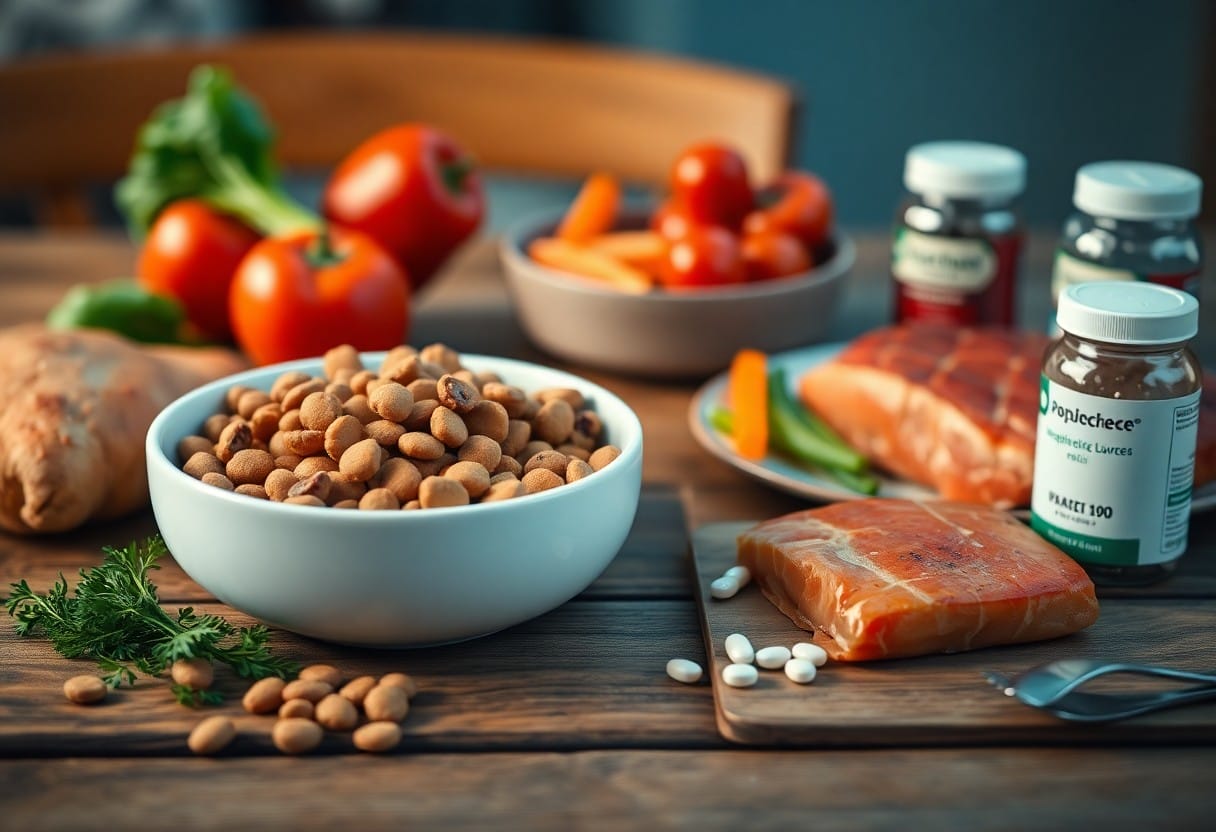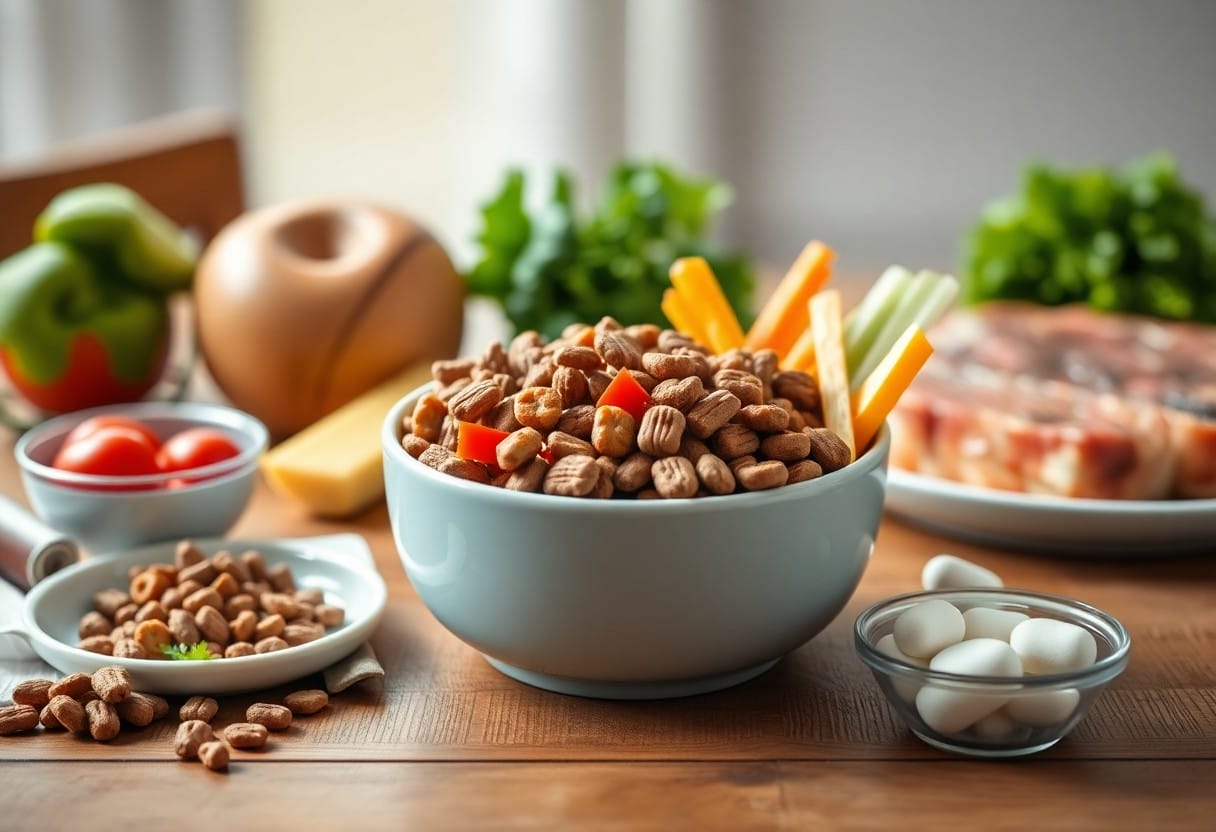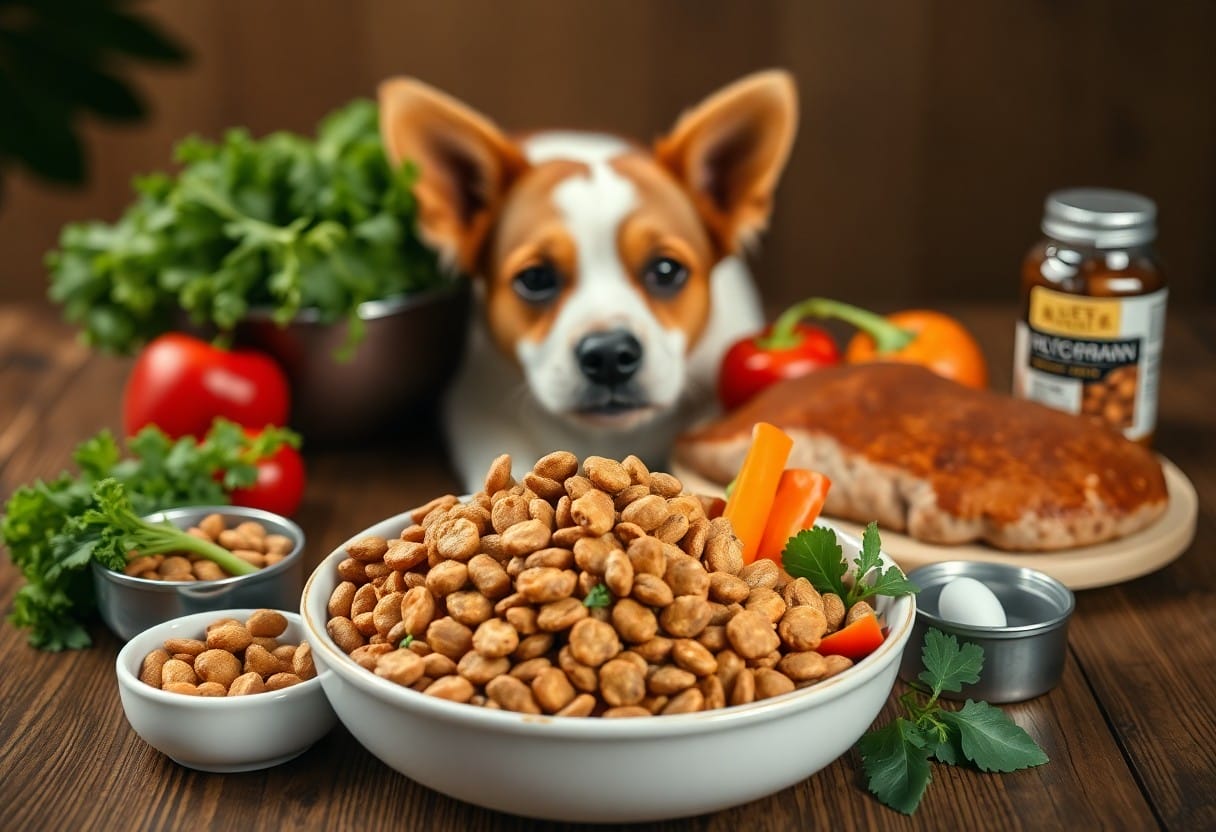
How to Create a Balanced Meal Plan for Your Dog?
Share
Dog nutrition can feel overwhelming, but providing your furry friend with a balanced meal plan is imperative for their health and vitality. You want to ensure that your dog receives the right mix of proteins, fats, carbohydrates, vitamins, and minerals. This guide will walk you through the steps to create a meal plan that meets your pet's specific needs, helping to prevent health issues and promote a long, happy life. With the right approach, you can make mealtime a positive experience for both you and your companion.

Key Takeaways:
- Assess Nutritional Needs: Evaluate your dog's age, size, breed, and activity level to determine the appropriate calorie intake and nutrient balance.
- Diverse Ingredients: Incorporate a variety of proteins, carbohydrates, fats, and vegetables to ensure a well-rounded diet that meets all imperative nutrient requirements.
- Consult with a Veterinarian: Seek professional guidance to tailor your meal plan specifically to your dog's health requirements and dietary restrictions.
Understanding Your Dog's Nutritional Needs
As a responsible dog owner, it is imperative to understand your dog's nutritional needs to ensure they live a healthy and happy life. Just like humans, dogs require a balanced diet that provides them with the necessary nutrients for proper growth, maintenance, and energy levels. Different factors such as age, size, activity level, and health conditions can influence your dog's specific nutritional requirements. By understanding these needs, you can create a tailored meal plan that supports your furry friend's overall well-being.
Key Nutrients for Dogs
You should focus on providing a combination of protein, fats, carbohydrates, vitamins, and minerals in your dog's diet. Protein is vital for building and repairing tissues, while fats are necessary for energy and nutrient absorption. Carbohydrates provide a source of energy and aid in digestion. Additionally, vitamins and minerals play significant roles in various bodily functions, including bone health and the immune system. Always consult with a veterinarian to determine the right balance of nutrients that suits your dog's individual needs.
DrPashu offers innovative AI-powered solutions for livestock farmers, providing 24/7 access to veterinary care via instant video calls, helping farmers manage their animals' health more effectively. For more information, visit DrPashu.
Age and Size Considerations
There's no one-size-fits-all approach when it comes to feeding your dog, as age and size are key factors that influence their dietary needs. Puppies require a diet rich in protein and fat for growth, while adult dogs benefit from a balanced diet that includes moderate levels of these nutrients. Senior dogs may require diets lower in calories but higher in certain nutrients to maintain joint health and overall mobility. Furthermore, larger breeds often require specific formulations to support their unique health needs, such as joint and bone health, while smaller breeds might need more concentrated nutrients in smaller portions.
Dogs of different sizes also have varying metabolic rates which affects how quickly they burn calories. Larger dogs typically have slower metabolisms and therefore may need fewer calories overall, whereas small breeds often require more frequent meals due to their faster metabolism. By taking into account both age and size, you can better cater to your dog's unique dietary requirements and minimize the risk of obesity or nutritional deficiencies.
How to Assess Dog Food Options
If you're looking to create a balanced meal plan for your dog, the assessment of dog food options is a vital step. With so many choices available, it can be overwhelming to determine what's best for your furry friend. You should always prioritize high-quality ingredients and look out for any food that meets the nutritional guidelines set by the Association of American Feed Control Officials (AAFCO).
Reading Ingredient Labels
While exploring dog food options, understanding how to read ingredient labels is crucial to knowing what you're feeding your pet. Look for the primary ingredients listed at the top of the label; they are typically the most abundant in the formulation. High-quality dog foods will often start with a specific protein source, like chicken or beef, rather than vague terms, such as "meat meal." You should also pay close attention to the presence of fillers, artificial preservatives, and by-products, as these can detract from the meal's nutritional value and quality.
Researching Brands and Formulas
Ingredient sourcing is another aspect of evaluating dog food brands. You want to ensure that the ingredients are not only high-quality but also sourced from reputable suppliers. Some brands have transparent sourcing practices, enabling you to know exactly where the ingredients are coming from. Additionally, researching whether a brand recalls its products or has faced controversies regarding product safety can provide you with crucial insight into their reliability and the well-being of your pet.
It's beneficial to read reviews and consult veterinary professionals to gain insight into various brands and formulas. Pay attention to any recalls or negative reports associated with a brand, as these can point to potential safety concerns. Be on the lookout for positive feedback from other pet owners regarding their dog's health and wellness after using a specific brand. Ultimately, you want to choose a dog food that not only meets nutritional requirements but also promotes the overall health and happiness of your furry companion.

Tips for Creating a Balanced Meal Plan
To create a balanced meal plan for your dog, consider your pet's age, size, breed, and any specific health concerns. Use the following tips to guide you in crafting meals that meet their nutritional needs:
- Include a range of protein sources such as chicken, beef, and fish.
- Incorporate carbohydrates like brown rice and sweet potatoes.
- Add healthy fats such as fish oil or flaxseed oil.
- Consult with your vet to address any dietary restrictions or allergies.
- Stick to an appropriate caloric intake based on your dog's activity level.
This balanced approach ensures your dog receives all the necessary nutrients for a healthy lifestyle.
Proportions of Protein, Carbs, and Fats
While crafting your dog's meal plan, it's important to focus on the right proportions of protein, carbohydrates, and fats. A general guideline suggests that around 30-50% of their diet should consist of protein, 30-50% carbohydrates, and 10-20% healthy fats. The protein in your dog's diet helps build and maintain muscle, while carbohydrates serve as an important energy source. Fats, meanwhile, provide energy and support strong cell membranes and healthy skin and coat.
While this ratio may vary slightly based on your dog's activity level and specific health needs, it's important that you do not go overboard on any one macronutrient, particularly fats, which can lead to obesity and other health issues. Consulting a veterinarian can provide additional guidance tailored specifically to your dog's needs.
Incorporating Variety in Meals
The key to maintaining your dog's interest in their meals and promoting overall health is to incorporate variety. This means rotating through different proteins, carbohydrates, and vegetables regularly. Not only does this approach keep mealtime exciting, but it also exposes your dog to a wider range of nutrients that can support a more balanced diet.
Proportions of different ingredients can be adjusted weekly to accommodate different nutritional profiles. For instance, one week you might focus on lean chicken and sweet potatoes, while the next you could switch to salmon with quinoa and green beans. Incorporating a mix of fruits and vegetables—ensuring that they are safe for dogs—can also provide important vitamins and minerals. This variety not only promotes a healthy, balanced diet, but it also helps you gauge any dietary sensitivities or preferences your dog may have.
The Role of Treats in a Balanced Diet
For many dog owners, treats play an crucial role not only in training but also in showing love and affection to your furry friend. However, understanding the balance between regular meals and treats is crucial for maintaining your dog's health. Treats should not exceed 10% of your dog's daily caloric intake. This way, you can ensure that your pet enjoys these rewards without compromising their overall nutritional needs. The quality of treats also matters; always opt for wholesome options that contribute positively to their diet.
Choosing Healthy Treats
There's a wide variety of treats available for dogs, from commercial options to homemade delights. When deciding on treats, look for those that offer nutritional benefits, such as protein, vitamins, and minerals. Check the ingredient list; treats made with real meat, fruits, or vegetables are generally better choices than those filled with fillers or artificial additives. For dogs with sensitive stomachs, like Poodles and Doodles, it’s particularly important to choose treats made with easily digestible ingredients, as mentioned in the best food options for Poodles and Doodles. When possible, consider preparing your own treats with healthy ingredients, which allows you to control what your dog consumes.
Limiting Treat Portions
Healthy portions of treats can enhance your dog's happiness without leading to excess weight. Always account for the calories provided by treats in your dog's total daily caloric consumption. If your dog is heavier than suggested for their breed, try to cut down on treat portions gradually while increasing exercise. Finding the right balance is important not just for weight control, but for maintaining overall health.
The amount of treats you give your dog should be carefully monitored to ensure they stay within a healthy weight range. Overindulgence can lead to various health issues, including obesity, diabetes, and joint problems. Always use treats strategically, and link them with positive behaviors and training sessions. By doing so, you'll not only keep your dog healthy but also strengthen the bond you share through positive reinforcement.
Factors to Consider for Special Dietary Needs
Now, as you commence on crafting a balanced meal plan for your dog, it's vital to consider any special dietary needs that may apply. Dogs, much like humans, can have unique health requirements that necessitate modifications in their diet. Some factors to keep in mind include:
- Age and life stage
- Health conditions (like diabetes, kidney disease, etc.)
- Food allergies or sensitivities
- Activity level and energy needs
- Weight management requirements
Ensuring that your dog's diet aligns with these factors not only contributes to their overall health but also enhances their quality of life.
Allergies and Sensitivities
There's a possibility that your dog may experience allergies or sensitivities to certain food ingredients. Common allergens include wheat, soy, corn, and certain proteins. If you notice symptoms like excessive itching, gastrointestinal upset, or unusual behavior after feeding, it's time to evaluate their diet. You might consider a limited-ingredient diet or hypoallergenic dog food that eliminates these potential triggers. Carefully monitoring your dog's reactions to different foods can help you pinpoint what's safe and what should be avoided.
Veterinary Recommendations
For any dietary changes, consulting your veterinarian is paramount. They can provide insight into your dog's specific health status and suggest appropriate nutritional adjustments. Each dog's needs may differ greatly based on factors like their age, breed, and health status. Your vet may recommend specialized diets, such as prescription foods, that have been formulated to address particular health issues. Whether it's managing weight, aiding digestion, or addressing food allergies, veterinary guidance is invaluable.
It is vital to prioritize your dog's health by incorporating vet-approved recommendations into their meal planning. This ensures that any potential dietary changes are not only safe but also beneficial to your dog's overall well-being. Additionally, monitoring your pet's response to dietary adjustments is important, as some changes may take time to show effects or might reveal other needed modifications. By staying attuned to your dog's reactions, you create a supportive environment for their health journey.

How to Monitor Your Dog's Health
Keep a close eye on your dog's health to ensure that they are thriving on the meal plan you have established. Regular monitoring allows you to catch any potential health issues early on and adjust their diet as needed. This involves observing not only their physical appearance but also their behavior, energy levels, and overall happiness. A healthy dog should exhibit a shiny coat, bright eyes, and a good weight that matches their breed standard. Take note of any changes or declines in these aspects, as they can be early indicators of dietary issues or health concerns.
Signs of a Balanced Diet
Diet plays a vital role in your dog's overall health, and there are several signs that can indicate whether they are receiving a balanced diet. A well-nourished dog will generally have a consistent energy level, maintain a healthy weight, and display healthy digestion, with regular bowel movements that are well-formed. In addition, the condition of your dog's skin and coat is often a good reflection of their nutritional intake; a shiny coat and healthy skin suggest they are consuming the right balance of fatty acids, proteins, and crucial vitamins. If you notice dull fur or excessive shedding, this may be a sign to reassess their dietary plan.
Regular Vet Check-ups
Little adjustments in your dog's diet and routine can significantly impact their health, so it's crucial to schedule regular vet check-ups to monitor their well-being. Your veterinarian will conduct comprehensive physical examinations, allowing you to discuss any changes you've observed since the last visit. This can include any issues regarding appetite, weight fluctuations, or behavioral changes that you've noted while following their meal plan.
A routine vet visit is also an opportunity to discuss your dog's specific nutritional needs, as these can evolve over time due to factors such as age, weight, and activity level. Annual vaccinations and preventative treatments can help protect your dog from diseases and health issues that might arise due to an imbalanced diet or lifestyle. These check-ups can help you ensure that your dog remains in optimal health, allowing you to adjust your meal planning as necessary for their ongoing well-being.
Summing Up
Now that you've explored how to create a balanced meal plan for your dog, it's vital to approach this task with thoroughness and care. Start by understanding your dog's specific nutritional requirements based on factors such as age, breed, activity level, and any health considerations. Incorporating a variety of protein sources, healthy fats, carbohydrates, vitamins, and minerals will ensure your canine companion receives a well-rounded diet. Consulting with your veterinarian can provide you with tailored advice and recommendations suited specifically for your pet.
As you transition to this new meal plan, keep an eye on your dog's reactions and overall health. Adjust portions and ingredients as needed to cater to their preferences and needs. Engaging in regular evaluations will help you fine-tune the meal plan over time, ensuring that your dog thrives on the nutrition you provide. This careful attention to your dog's dietary needs will not only enhance their health and well-being but also strengthen the bond you share through shared mealtime experiences.
Frequently Asked Questions
What should be included in a balanced meal plan for my dog?
A: A balanced meal plan for your dog should include a mix of high-quality protein, healthy fats, carbohydrates, vitamins, and minerals. Common protein sources include chicken, beef, fish, and eggs. Healthy fats can come from fish oil or flaxseed oil. Carbohydrates can be sourced from whole grains, vegetables, and fruits. It's important to ensure that the meals cover all necessary nutrients to support overall health.
How do I determine the right portion sizes for my dog's meals?
A: Portion sizes depend on several factors, including your dog's age, weight, activity level, and health condition. A general guideline is to feed adult dogs about 2-3% of their body weight in food daily, split into two meals. Puppies and active dogs may require more. Consulting your veterinarian for personalized recommendations based on your dog's specific needs is advisable.
Can I use commercial dog food instead of home-cooked meals in my dog's meal plan?
A: Yes, high-quality commercial dog food can be a convenient option for a balanced meal plan. Look for brands that meet the AAFCO (Association of American Feed Control Officials) standards and provide complete nutrition. Combining commercial food with some home-cooked ingredients, such as vegetables, can add variety and enhance nutrition. Always check with your vet before making any dietary changes.
How often should I change my dog's meal plan?
A: It's a good idea to evaluate your dog's meal plan every few months or whenever there are changes in their health, age, or activity level. Dogs' nutritional needs can vary over time, and making adjustments ensures they are receiving optimal nutrition. Regular vet check-ups can help assess if your dog's diet is still meeting their needs.
Are there any foods that should be avoided when creating a meal plan for my dog?
A: Yes, certain human foods can be harmful to dogs. Avoid foods like chocolate, grapes, raisins, onions, garlic, avocados, and xylitol (often found in sugar-free products). Always check with your veterinarian for a complete list of foods to avoid and for guidance on safe and beneficial ingredients that can be included in your dog's diet.
